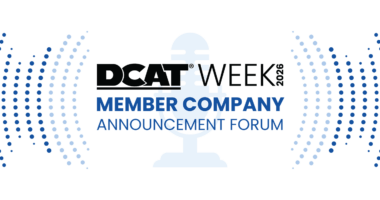Measuring Innovation: Where Does the Pharma Industry Stand?
Annual worldwide research and development (R&D) spending reached $700 billion for the top 1,000 corporate R&D spenders, according to a recent analysis by PwC, with Amazon becoming the world’s largest corporate spender on R&D at more than $16 billion. So how do pharmaceutical companies rank in terms of R&D spending?
Overall, software and internet industry companies continue to increase their year-on-year R&D spending, and the analysis shows that by 2018, healthcare companies will surpass computing and electronics to become the largest industry in terms of R&D spending, the first time in 12 years of the PwC analysis. DCAT Value Chain Insights examines the numbers.
Overall corporate R&D spending
Annual worldwide corporate R&D spending was $702 billion in 2017, according to an annual analysis of R&D spending across 1,000 global public companies by PwC. The study, PwC’s Global Innovation 1000, which analyzes spending at the world’s 1,000 largest publicly listed corporate R&D spenders and is now in its thirteenth year, showed that corporate R&D spending increased at 3.2% in 2017, bouncing back from less than a 1% increase in 2016. Worldwide R&D spending among the world’s 1,000 largest corporate R&D spenders increased only 0.04% in 2016 to $680 billion. R&D intensity, a measure of R&D spending relative to sales, hit an all-time study high of 4.5%: a rise of 6% year on year among the world’s top 1,000 R&D spenders.
Overall, computing and electronics, healthcare (inclusive of the pharmaceutical industry), and automotive are the top three industry sectors and represented 61.3% of global R&D spending in 2017. Amazon was the largest spender on R&D in the Global Innovation 1000 study, the first time the top spender is a high-tech firm. All top four spenders (Amazon, Alphabet [i.e., Google], Intel, and Samsung Electronics) are high-tech companies. As a group, the companies of the top 20 spent $194.5 billion on R&D in 2017; this figure represented 28% of the total spending of all the companies in the Global Innovation 1000.Thirteen of the top 20 spenders in 2017 were headquartered in the US, reflecting US dominance in the high-tech and healthcare industries, which tend to have high R&D intensity.
The top four industries by R&D spending (computing and electronics, healthcare, auto, and software and Internet) together accounted for more than 75% of all R&D spending by the Global Innovation 1000 companies. Healthcare companies increased R&D outlays by 5.9% in 2017 and are on track to supplant computing and electronics as the top R&D industry spender in 2018. Meanwhile, growth in R&D spending for software and Internet companies, at 16.1%, was once again the fastest of all industries. Given their current trajectory, software and Internet companies will take the number three industry position in 2018, surpassing auto companies. The software and Internet and healthcare industries also added the largest number of companies to the Global Innovation 1000 in 2017: 13 new arrivals from the software and Internet sector, and nine from the healthcare sector.
Overall, 24 pharmaceutical companies made the list of the top 100 R&D spenders. Three pharmaceutical companies (Roche, Merck & Co., and Novartis) were ranked in the top ten for R&D spending, respectively ranked seventh, eighth, and tenth. Johnson & Johnson (#12), Pfizer (#14), AstraZeneca (#21), Sanofi (#24), and Eli Lilly and Company (#25) were in the top 25.
Honda and Facebook joined the ranks of the top 20 spenders in 2017 in the 19th and 20th places, respectively, replacing two pharmaceutical firms, AstraZeneca and Bristol-Myers Squibb, who moved down the list. How did the rest of the pharmaceutical industry fare? Eight other pharmaceutical companies were in the top 50 of R&D spenders: Gilead Sciences (#27), Bristol-Myers Squibb (#29), Bayer (#30), GlaxoSmithKline (#35), Celgene (#36), AbbVie (#38), and Amgen (#41). The remaining pharmaceutical companies in the top 100 were: Takeda Pharmaceutical (#51), Allergan (#54), Teva Pharmaceutical Industries (#63), Merck KGaA (#65), Novo Nordisk (#66), Regeneron Pharmaceuticals (#67), Biogen (#69), Daiichi Sankyo (#72), and Astellas (#74). Otsuka Pharmaceutical was just outside the top 100 and came in at number 101.
In looking at R&D intensity in 2017, the measure of R&D spending relative to sales, among top pharmaceutical R&D spenders, Regeneron Pharmaceuticals (42.2%) and Celgene (39.8%) had the highest R&D intensity, and Bayer (10%) and Teva (9.6%) the lowest. In looking at the top 10 pharmaceutical companies in terms of R&D spend, R&D intensity ranged from nearly 15% to 26%. Roche, the top pharmaceutical company in terms of absolute R&D spend, had an R&D intensity of 21.9%. Other pharmaceutical companies’ R&D intensity were: Merck & Co. (25.4%), Novartis (19.4%), Johnson & Johnson (12.7%), Pfizer (14.9%), AstraZeneca (25.6%), and Sanofi (14.9%).
Issues impacting R&D
In a separate PwC study of 562 executives, companies expressed some concern over issues that may impact a strategy of having global integrated R&D operations. In 2015, 94% of major corporations conducted their R&D in multiple locations, but increasing attention on regulations and policies for visas, labor movement, and the regulations governing the sharing of knowledge and technology are causing some companies to question how sustainable their integrated global innovation networks are. Nearly 33% of R&D executives surveyed in the PwC study, report that they have already felt the effects of economic nationalism on their R&D talent acquisition or retention because of visa or work restrictions either by losing employees, seeing less talent available, or in hiring more local talent. Although nearly 66% of all participants surveyed say they have not experienced pressure to change their approach to innovation in their headquarters country to date, 23% say they have already experienced such pressure in another country. Almost 50% of the companies in North America plan to make changes to their R&D programs over the next two years in response to the changing policy environment.
“Although the goals and levels of investment in corporate innovation will likely not change if economic nationalism continues to develop, the global innovation model would need to evolve,” said Barry Jaruzelski, principal in PwC’s strategy consulting business, in commenting on the study. “At many companies, what is now a nimble, interdependent network may become a group of more autonomous hubs, hiring specialist technical talent in local regional markets and opening future R&D centers in regional markets. It could mean companies losing efficiency and taking on higher costs if it is not managed effectively.”
Survey participants believed the US, UK, and China could be most at risk from potential changes in policy that could impact R&D investment. Both the US and UK’s talent flow could be at risk of potential disruption while China’s decline in corporate R&D spending and reliance on R&D investment from abroad could be at risk.







